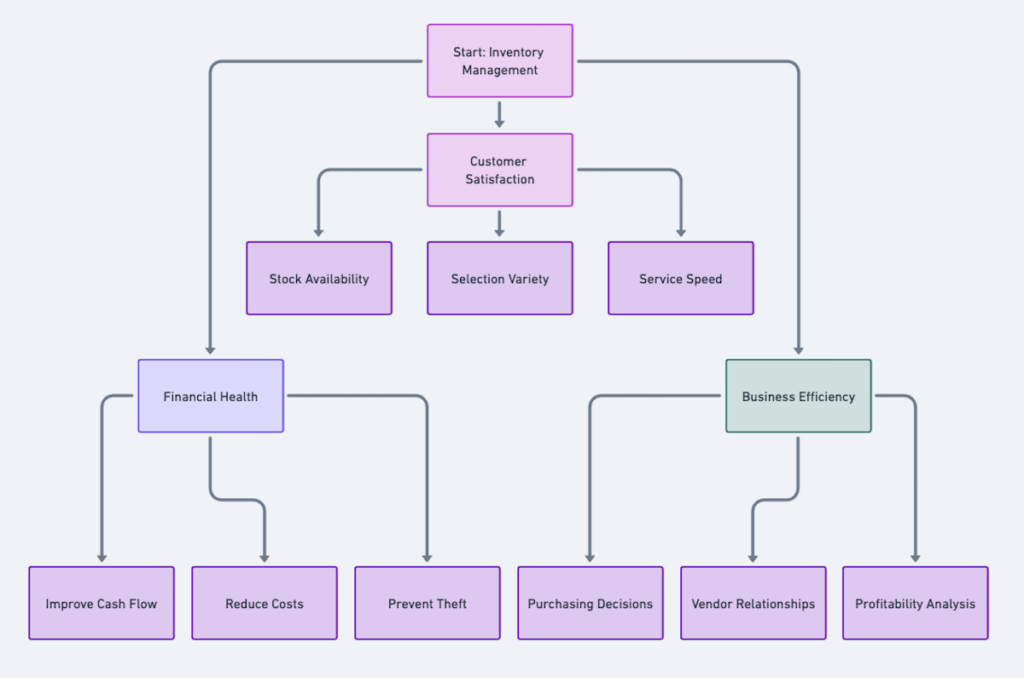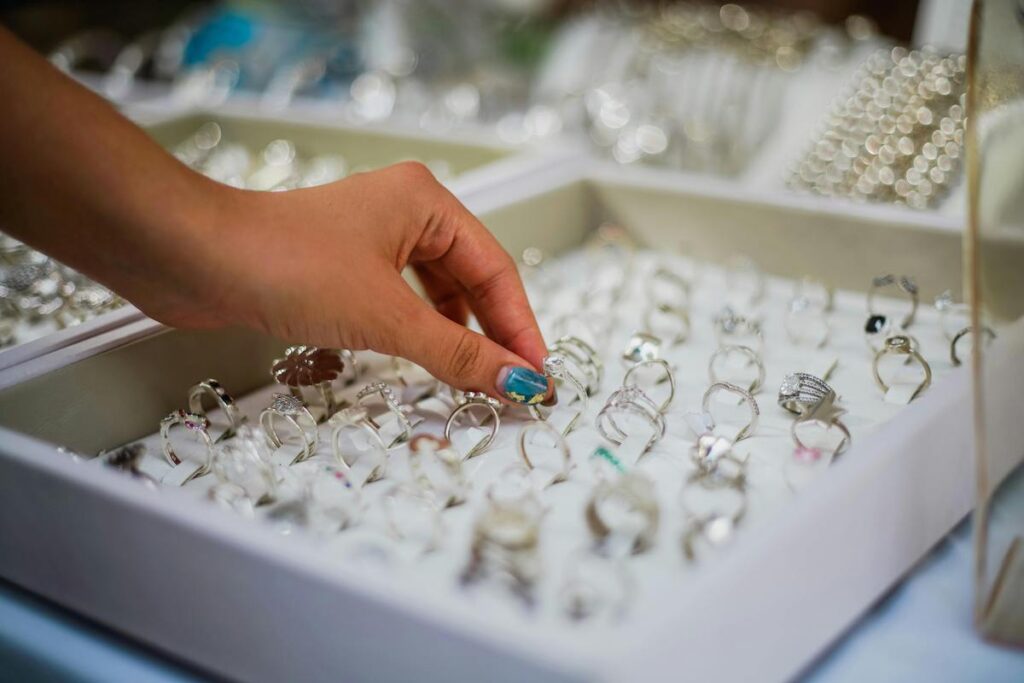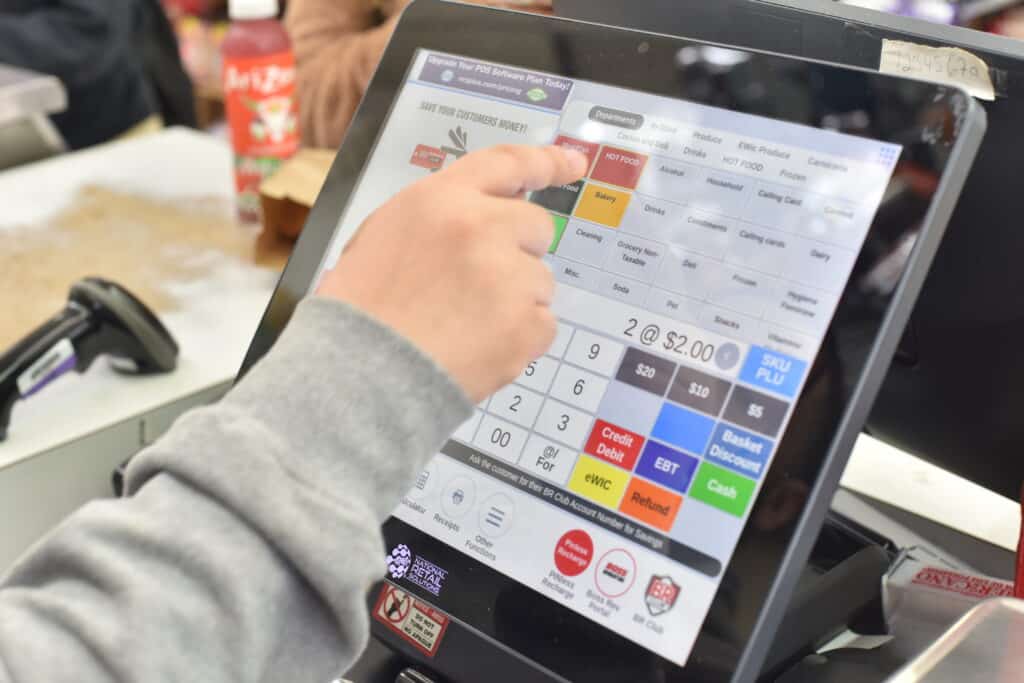- Retailers worldwide lose $1.75 trillion annually due to bad inventory management.
- The right point of sale system will effortlessly manage inventory at a jewelry store.
- Accurate inventory management increases customer satisfaction and boosts sales.
The Benefits of Effective Inventory Management at a Jewelry Store
Inventory management keeps a jewelry store financially healthy, operationally efficient, and well-positioned to meet customer needs and maximize profits.

Financial Advantages:
- Reduced Costs: Prevents overstocking, which ties up capital in unsold stock and requires extra storage space. You’ll also avoid unnecessary markdowns to clear out old stock.
- Improved Cash Flow: By having the right goods at the right time, you can consistently meet customer demand and generate sales, leading to better cash flow.
- Theft Prevention: Accurate supply records help identify discrepancies and potential theft, protecting your valuable merchandise.
Customer Satisfaction:
- Stock Availability: Prevents stockouts that disappoint customers and lead to lost sales. You can ensure you have the most popular items when customers look for them.
- Wider Selection: Effective management allows you to offer a variety of jewelry pieces without overextending your budget, catering to diverse customer preferences.
- Faster Service: Knowing exactly where your stock is allows staff to locate and serve customers efficiently.
Business Efficiency:
- Informed Purchasing: Inventory data helps you understand what sells well and what doesn’t. You can then make data-driven decisions about future purchases and avoid buying slow-moving items.
- Profitability Analysis: By tracking sales data alongside product costs, you can analyze which items have the highest profit margins and optimize your product mix.
- Stronger Vendor Relationships: Accurate ordering based on actual sales helps maintain good relationships with vendors by avoiding order cancellations or returns.
Additional Benefits:
- Improved Organization: A well-managed inventory leads to a more organized store environment, making it easier for staff to find items and present them professionally to customers.
- Better Decision-Making: Inventory data is a goldmine of insights that inform various business decisions, like marketing strategies, pricing adjustments, and store layout optimization.
How Jewelry Stores Source Their Inventory

Purchasing from Wholesalers
- Diamond Districts: Many jewelry store owners travel to diamond districts in major cities (like New York City) to hand-select diamonds, gemstones, and finished pieces from wholesalers specializing in these areas.
- Trade Shows: Large-scale jewelry trade shows bring together wholesalers and manufacturers, allowing jewelry stores to discover new products and make bulk purchases. These shows often offer the chance to see the latest trends.
- Direct Relationships: Jewelry stores sometimes establish direct connections with wholesalers and purchase regularly from a select few they trust.
Working with Designers and Manufacturers
- Custom and Unique Pieces: Stores may work with independent jewelry designers to create exclusive pieces or collections for their clientele.
- Small-Batch Manufacturers: Partnering with manufacturers allows stores to offer larger quantities of a particular design, ensuring they have sufficient stock.
Making Their Jewelry
- In-House Jewelers: Some larger or high-end jewelry stores employ jewelers who design and create unique pieces on-site. This offers customers total control and exclusivity.
Other Sources
- Consignment: Stores may take select jewelry pieces from individuals on consignment, selling these items on behalf of the owner for a commission.
- Estate Sales: Jewelry stores sometimes search through estate sales and auctions to find unique vintage or antique pieces to add to their collection.
Best Practices for Jewelry Inventory Management
Jewelry stores use various techniques to manage their stock effectively. Here’s a breakdown of the critical aspects:
1. Inventory Tracking Systems
- Point of sale (POS) Systems: Modern POS systems for jewelry stores offer sophisticated tracking features. They record sales, monitor stock levels in real time, generate low-stock alerts, and provide valuable sales data.
- Inventory Management Software: Specialized software provides even more robust features, such as detailed item descriptions, multiple location tracking, vendor management, and customized reports.
2. Organization and Labeling
- Clear Labeling: Each item needs a unique tag or barcode containing essential information (SKU, metal type, gemstone, price, vendor, etc.). Labeling ensures easy identification and accurate tracking.
- Categorization: Group your inventory logically (rings, earrings, necklaces, by metal, by designer, etc.) for efficient storage and retrieval.
- Secure Storage: Invest in secure storage solutions like safes, lockable display cases, and organized stock rooms. High-value items need extra security measures.
3. Regular Inventory Audits
- Physical Stock Counts: Conduct frequent physical counts, especially for high-value or fast-moving items, to ensure your records match your products. This helps identify discrepancies, theft, or damage.
- Cycle Counts: Instead of counting everything at once, focus on counting smaller sections of your inventory rotating. This is less disruptive to store operations.
4. Sales Analysis and Forecasting
- Tracking Sales Trends: Use your POS and inventory system to understand which pieces sell well, what price points are popular, and if there are seasonal fluctuations in demand.
- Forecasting Demand: Use historical sales data to predict future demand. It will enable you to replenish stock promptly and avoid stockouts for popular items.
The Advantages of a POS System with Integrated Inventory Management

A modern point of sale system with a built-in, dedicated inventory management module can significantly benefit jewelry stores by streamlining processes, improving accuracy, and providing valuable data for better decision-making. Here’s how these systems can help:
Enhanced Inventory Tracking:
- Real-Time Updates: Every sale is automatically reflected in the inventory, providing an accurate picture of stock levels at all times, eliminating discrepancies, and ensuring you always have the latest information.
- Low-Stock Alerts: The system can set automatic alerts when product levels fall below a pre-determined threshold, which helps prevent stockouts and ensures timely reordering to maintain customer satisfaction.
- Detailed Product Information: Modern POS systems capture rich product details beyond quantity. You can store information like gemstone type, cut, clarity, carat weight, metal type, and images. It facilitates better organization and retrieval of specific pieces.
Streamlined Operations:
- Faster Transactions: Sales staff can quickly access real-time inventory data and product details, providing quicker and more efficient customer service.
- Automated Reordering: Some systems can automatically suggest reorders based on sales history and minimum stock levels. This automation reduces the risk of human error and frees up staff time for other tasks.
- Barcode Scanning: Barcode scanners track goods during sales and receiving. The scanner eliminates manual data entry, minimizes errors, and speeds up transactions.
Improved Decision-Making:
- Sales Analysis: The point of sale system can generate reports that analyze sales trends by item type, gemstone, price point, and even metal. This valuable data helps you understand customer preferences and optimize your merchandise mix to maximize profitability.
- Vendor Management: Track purchases from different vendors, analyze their performance, and identify the most reliable and cost-effective suppliers.
- Targeted Marketing: Leverage sales data to identify popular items and create targeted marketing campaigns to promote specific pieces or collections.
Additional Advantages:
- Security: Modern cash registers have robust security features to protect sensitive customer and stock data.
- Scalability: These systems can grow with your business. As your stockpile expands, the system can handle the increased complexity.
- Integration: Many point of sale systems integrate seamlessly with other business applications, such as accounting software and email marketing platforms, creating a more streamlined workflow.
FAQ
Q: How do jewelry stores decide what inventory to carry?
Answer: Jewelry stores consider customer preferences, current trends, their niche, and budget when selecting inventory.
Q: Can jewelry stores control the design of their inventory?
Answer: Stores can work with designers and manufacturers or have in-house jewelers to create custom or unique pieces.
Q: Do jewelry stores ever sell used or vintage jewelry?
Answer: Some stores may offer consignment pieces or source vintage jewelry from estate sales and auctions.
Q: Why is it important for jewelry stores to track their inventory?
Answer: Inventory tracking helps manage costs, prevent stockouts, ensure customer satisfaction, and make informed business decisions.
Q: What kind of technology do jewelry stores use for inventory management?
Answer: Many stores use specialized systems with integrated tracking features or dedicated management software.
Struggling to manage your jewelry store inventory? National Retail Solutions (NRS) offers robust POS systems with built-in inventory management features to streamline your jewelry store operations, boost profits, and keep your customers happy.
Contact NRS today for a free consultation!








